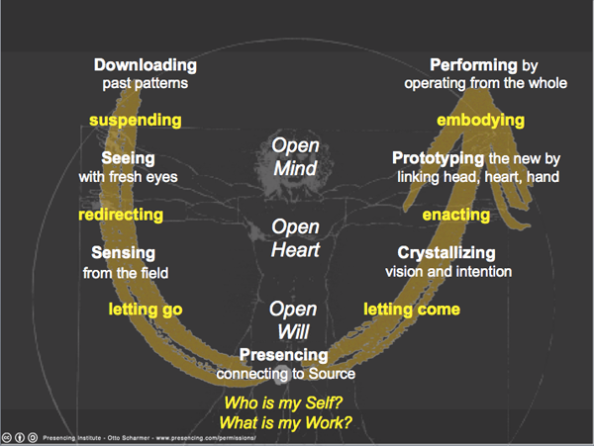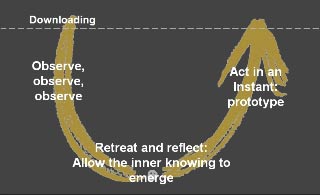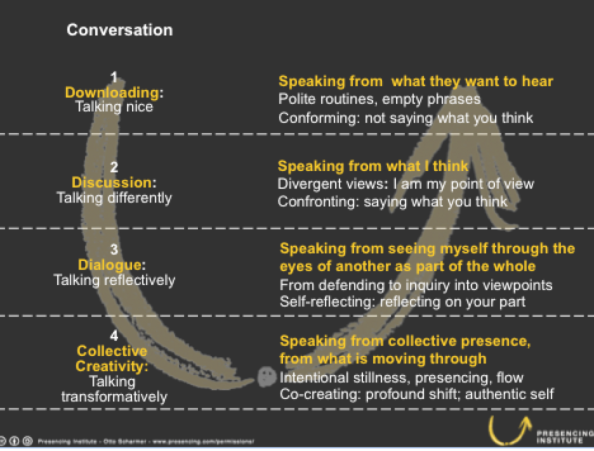“When you turn your head from horizon to horizon your eyes see a vast space in which all the things of the earth and of the sky appear. But this space is always limited where the earth meets the sky. The space in the mind is so small. In this little space all our activities seem to take place: the daily living and the hidden struggles with contradictory desires and motives. In this little space the mind seeks freedom, and so it is always a prisoner of itself. Meditation is the ending of this little space. To us, action is bringing about order in this little space of the mind. But there is another action which is not putting order in this little space. Meditation is action which comes when the mind has lost its little space. This vast space which the mind, the I, cannot reach, is silence. The mind can never be silent within itself; it is silent only within the vast space which thought cannot touch. Out of this silence there is action which is not of thought. Meditation is this silence.” . – Krishnamurti, Meditations, 1969
Theory U: leading from the future as it emerges.
This is considered a form of mindfulness and also a social technology for transformation; individually, organizationally, and systemically.
“The success of an intervention depends on the interior condition
of the intervenor.”
Below are some quotes:
“Across the board, we collectively create outcomes that nobody wants. Yet the key decision makers do not feel capable of redirecting this course of events in any significant way. They feel just as trapped as the rest of us in what often seems to be a race to the bottom. The same problem affects our massive institutional failure: we haven’t learned to mold, bend, and transform our centuries-old collective patterns of thinking, conversing, and institutionalizing to fit the realities of today.”
“What is seen rising is a new form of presence and power that starts to grow spontaneously from and through small groups and networks of people. It’s a different quality of awareness and connection, a different way of being present with one another and with what wants to emerge. We see that in many forms: volunteers in Europe who come together to support the incoming stream of refugees and grassroots local movements collaborating across cultures…. When groups begin to operate from a real future possibility, they start to tap into a different social field from the one they normally experience. It manifests through a shift in the quality of thinking, conversing, and collective action. When that shift happens, people can connect with a deeper source of creativity and knowing and thus move beyond the patterns of the past. They step into their real power, the power of their authentic self. I call this change a shift in the social field because that term designates the totality and type of connections through which the participants of a given system converse, think, and act.
Addressing the Blindspot of our Time
An Executive Summary of Theory U: leading from the future as it emerges.
See more at http://www.ottoscharmer.com/
Four Levels of Listening (C. Otto Scharmer)
Downloading – “yeah, I know that already..” re-confirm what I already know. (I-in-ego/Politeness)
Listening from the assumption that you already know what is being said, therefore you listen only to confirm habitual judgments.
Factual – pick up new information…factual, debates, speak our mind (I-in-it/Debate)
Factual listening is when you pay attention to what is different, novel, or disquieting from what you already know.
Empathic – see something through another person’s eyes, I know exactly how you feel. Forget my own agenda (I-in-thou/Inquiry)
Empathic listening is when the speaker pays attention to the feelings of the speaker. It opens the listener and allows an experience of “standing in the other’s shoes” to take place. Attention shifts from the listener to the speaker, allowing for deep connection on multiple levels.
Generative – “I can’t explain what I just experienced”
(I-in-now/Flow)
This deeper level of listening is difficult to express in linear language. It is a state of being in which everything slows down and inner wisdom is accessed. In group dynamics, it is called synergy. In interpersonal communication, it is described as oneness and flow.
C. Otto Scharmer is a senior lecturer at M.I.T.
Seven Theory U Leadership Capacities
The journey through the U develops seven essential leadership capacities.
1. Holding the space of listening.
The foundational capacity of the U is listening. Listening to others. Listening to oneself. And listening to what emerges from the collective. Effective listening requires the creation of open space in which others can contribute to the whole.
2. Observing.
The capacity to suspend the “voice of judgment” is key to moving from projection to true observation.
3. Sensing.
The preparation for the experience at the bottom of the U – presencing – requires the tuning of three instruments: the open mind, the open heart, and the open will. This opening process is not passive but an active “sensing” together as a group. While an open heart allows us to see a situation from the whole, the open will enables us to begin to act from the emerging whole.
4. Presencing.
The capacity to connect to the deepest source of self and will allows the future to emerge from the whole rather than from a smaller part or special interest group.
5. Crystalizing.
When a small group of key persons commits itself to the purpose and outcomes of a project, the power of their intention creates an energy field that attracts people, opportunities, and resources that make things happen. This core group functions as a vehicle for the whole to manifest.
6. Prototyping.
Moving down the left side of the U requires the group to open up and deal with the resistance of thought, emotion, and will; moving up the right side requires the integration of thinking, feeling, and will in the context of practical applications and learning by doing.
7. Performing.
A prominent violinist once said that he couldn’t simply play his violin in Chartres cathedral; he had to “play” the entire space, what he called the “macro violin,” in order to do justice to both the space and the music. Likewise, organizations need to perform at this macro level: they need to convene the right sets of players (frontline people who are connected through the same value chain) and to engage a social technology that allows a multi-stakeholder gathering to shift from debating to co-creating the new.
Theory U Encourages You to Step into the Emerging Future.
Examples of these seven Theory U leadership capacities can be found in a number of multi-stakeholder innovations and corporate applications. The Presencing Institute is dedicated to developing these new social technologies by integrating science, consciousness, and profound social change methodologies.
Video: Transforming Business, Society, and Self
Video: Applying mindfulness, not only to the self, but to the level of the collective. Paying attention to our attention and intention. From Ego-system to Eco-system Economies
Video: Four Levels of Listening
The U process: presencing or mindfulness

Simplified version

Mindfulness in dialog
Mindfulness in listening

Simplified

“The shift of a social field is more than a memorable moment. When it happens, it tends to result in outcomes that include a heightened level of individual energy and awareness, a sustained deepening of one’s authenticity and personal presence, and a clarified sense of direction…”
(Otto Scharmer, Theory U)
On Knowing
 “Knowledge without context is not knowledge; it’s just information” (Ikujiro Nonaka, Dynamic Theory of Organizational Knowledge Creation)
“Knowledge without context is not knowledge; it’s just information” (Ikujiro Nonaka, Dynamic Theory of Organizational Knowledge Creation)
There is no authentic knowing outside of the context of relationship.
Without direct experience, “truth” loses its integrity.
If truth with direct experience is subject to interpretation (or possible fallacy),
Then truth without direct experience is little more than hearsay (or possible heresy).
On Silence
“The true spiritual urge or yearning is always an invitation beyond the mind. That’s why it’s always been said that if you go to God, you go naked or you don’t go at all. It’s the same for everybody. You go in free of your accumulated knowledge, or you are forever unable to enter. So an intelligent mind realizes its own limitation, and it’s a beautiful thing when it does.
“When you stop holding on to all of the knowledge, then you start to enter a different state of being. You start to move into a different dimension. You move into a dimension where experience inside gets very quiet. The mind may still be there chatting in the background, or it might not, but consciousness is no longer bothering itself with the mind. You don’t need to stop it. Your awareness just goes right past that wall of knowledge and moves into a very quiet state.
“In this quietness, you realize that you don’t know anything simply because you aren’t looking back to the mind for its acquired knowledge. This quietness is a mystery to the mind. It is something unknown. As you go into depth, you literally go into a deeper experience of what seems to be a great mystery. Now the mind might come in and want to know what’s going on and start to define everything, but that’s not going to bring any more depth. The mystery just keeps opening to itself if you let it– if you let go of control.”
-ADYASHANTI
On Presence
Check out my blog posts:
Presence — Living from the Source
Presence
